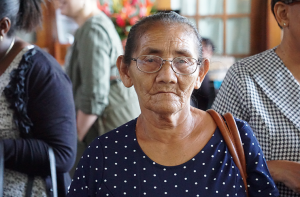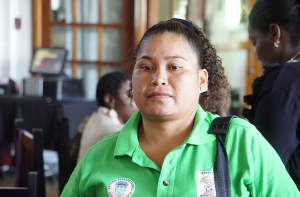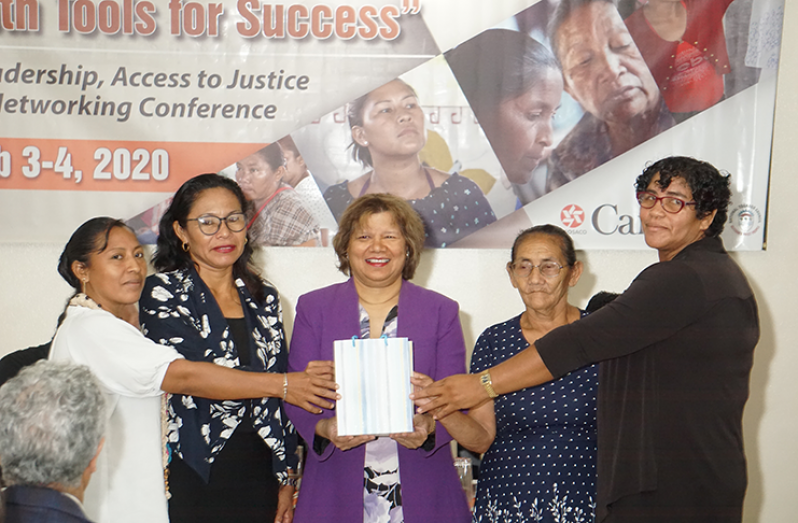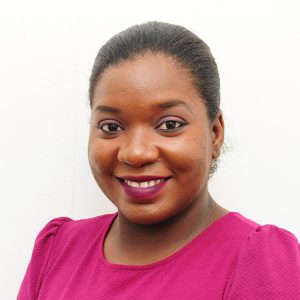…Canadian envoy declares as leadership conference opens
By Svetlana Marshall
INDIGENOUS women here have been making notable strides and more of them are now breaking into top leadership positions, Canadian High Commissioner to Guyana, Lilian Chatterjee, on Monday, told the opening of a two-day Indigenous Women Leaders’ Conference being held at the Grand Coastal Hotel.
The conference is being held under the theme “Equipping Indigenous Women with Tools for Success: Leadership, Access to Justice and Networking,” an Indigenous Women Leaders.’
The two-day conference, organised by the Canadian High Commission, the Canadian Executive Service Organization (CESO), and the National Toshaos Council (NTC), is being attended by female Toshaos and village leaders from across the country. In delivering remarks during the opening ceremony, Chatterjee said the tide is turning, with more and more indigenous women assuming official leadership roles within their villages.

Traditionally, not many indigenous women in Guyana assumed official leadership positions.
“In 2018, of 116 Indigenous Villages, 14 female Toshaos were sworn in. I understand this has now grown to 15,” the Canadian High Commissioner pointed out.
Providing insight on history of the conference, Commissioner Chatterjee disclosed that it was former Chairman of the NTC, Lenox Shuman, who had lobbied her office to recognise indigenous women for the important roles they were playing in the development of their villages.
“During our discussion, these Toshaos requested leadership training from Canada, given our indigenous heritage. I was so pleased to ask Chief Glenn Nolan, a leader in indigenous communities in Canada, to provide this training,” she recalled while noting that Chief Nolan’s training was just the beginning.
While the training was well received, the Canadian High Commissioner noted that more knowledge, networking, resources and leadership training were requested to help to fully equip indigenous leaders to manage the issues facing their communities. The ongoing training, she posited, will not only build on the initial training, but the work done by the NTC in fostering greater women leadership within villages.

Photos by Elvin Croker
“Today’s training will not solve all problems; but it is meant to help give women leaders tools and information to use in their roles. It is also meant to highlight indigenous peoples’ and women’s rights, and how to access rights using the current justice system. In fact, all of today is dedicated to showing you women leaders how best to use your justice system – what tools are out there? Who can you turn to? Are you able to use the system?” she explained.
Pointing to the experts present from the judiciary, police, academia and social services, the Canadian High Commissioner said the indigenous leaders will be provided with the help needed to navigate the system. “Our goal therefore, is to foster dialogue which will help improve the justice system for you and indigenous people while giving you the information and tools you need to access it,” she noted.
Today, the indigenous women leaders will undergo skills-building training that would allow them to function effectively within the Village Councils. “You have a heavy weight on your shoulders – you are leaders in your community and you are a minority. We hope that this event enables you to share with each other, to help each other, to provide support to each other in your roles. Your experiences are important and can help your fellow Toshaos,” High Commissioner Chatterjee challenged the leaders present.
To foster greater networking, the Canadian High Commission presented the indigenous women leaders with smart phones.

Chairman of the National Toshaos Council, Nicholas Fredericks, told the Guyana Chronicle that the training is important and timely. While the conference, in part is focusing on access to justice, Fredericks said emphasis will be placed on the budding Oil and Gas Industry. The indigenous women along with the facilitators, he posited, are exploring avenues for possible development within the Oil and Gas Industry. As such, they will be brought up to date on the draft Local Content Policy and the National Resources Fund Act and other legislation and policies that govern the industry.
Orleen Williams, Toshao of Red Hill Village, Region One (Barima-Waini) was among the indigenous leaders present. Williams, who governs the village with a population of 400 people, said the training will build her capacity to respond to the needs of her people.
Elizabeth Ramacindo, Bumbery Hill Toshao (Region One) also echoed similar sentiments. “I think the training is good because it will help me as a leader to motivate the rest of women, and bring them together,” she told this newspaper. Her village has approximately 250 persons.
Chief Glenn Nolan, Chief Anna Achneepineskum from Canada; Justice Sandra Kurtzious; Director of Public Prosecutions, Shalimar Ali-Hack; and Deputy Commissioner of Police, Maxine Graham were among the officials present.



.jpg)










